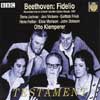Beethoven Fidelio
A live Klemperer Fidelio to put the lauded studio production in the shade
View record and artist detailsRecord and Artist Details
Composer or Director: Ludwig van Beethoven
Genre:
Opera
Label: Testament
Magazine Review Date: 2/2004
Media Format: CD or Download
Media Runtime: 163
Mastering:
Mono
ADD
Catalogue Number: SBT21328

Tracks:
| Composition | Artist Credit |
|---|---|
| Fidelio |
Ludwig van Beethoven, Composer
Elsie Morison, Marzelline, Soprano Forbes Robinson, Don Fernando, Bass Gottlob Frick, Rocco, Bass Hans Hotter, Don Pizarro, Alto John Dobson, Jaquino, Tenor John Vickers, Florestan, Tenor Joseph Ward, First Prisoner, Tenor Ludwig van Beethoven, Composer Otto Klemperer, Conductor Royal Opera House Chorus, Covent Garden Royal Opera House Orchestra, Covent Garden Sena Jurinac, Leonore, Soprano |
Author: Alan Blyth
As month follows month and more and more live performances appear, our perspective on the purpose of recordings seem to be changing. In December we had Maria Callas’s 1952 Covent Garden Norma superseding her studio efforts; and here is the first night of Otto Klemperer’s legendary 1961 Fidelio, also from the Royal Opera House, to challenge his noted studio set from a year later.This confirms the Achilles’ heel of Walter Legge, EMI’s leading mogul at the time, in his unwillingness to record live occasions, probably because he liked to have every aspect of a recording under his control. In this case there is more to it than that. Klemperer wanted, in the studio, to retain his Covent Garden cast; Legge preferred to make changes with two exceptions (Jon Vickers and Gottlob Frick). On the evidence of this magnificent issue, Klemperer was right. Not only are the singers, by and large, better equipped for their roles, but given the electricity of the occasion the conductor’s interpretation is more vital (often faster tempi) and even more eloquent. For his own staging, Klemperer decided to include far more dialogue than is usually heard (so, incidentally, did Böhm in 1978) so that we have as much a play with music as an opera. The singers speak and act with such feeling and immediacy, most particularly Jurinac, Hotter and Frick, as to justify the added text. Add to that the dedication on all sides to Klemperer, articulated by Mike Ashman in his booklet article for which he interviewed surviving singers and players, and you can imagine why this was such a special occasion. Compared to Christa Ludwig on Klemperer’s studio version, Sena Jurinac creates a more believable and vulnerable Leonore. Her heartfelt sympathy with the role is evident in every line she speaks and sings, most notably in key phrases in her duet with Rocco near the end of Act 1 and the melodrama in Act 2. Once past some first night nerves evident in ‘Abscheulicher!’ she proves an ideal Leonore. Vickers, even in these early days of his career, is inclined to sentimentalise his Florestan with scoops and lachrymose effects, but all is forgiven when he provides the heroic thrust and inner feeling which the part demands and which is so notably absent from the Florestan on the recent Rattle version. Frick’s Rocco is, if possible, even more admirable than on the studio set, expressing the jailor’s terrible dilemma in the kind of incisive, warm tones few other basses on disc match. It is incomprehensible that Legge preferred as Pizarro the too-comfortable sounding Walter Berry to Hans Hotter. Hotter, usually known for his noble roles, is here the epitome of evil, a threatening force of nature, his voice and diction full of menace so that he can be forgiven one or two wobbles in his aria. The young lovers are personably sung and enacted by Elsie Morison and John Dobson, and another Royal Opera stalwart, Forbes Robinson, is a dignified Don Fernando. There was a fuss at the time about Klemperer’s inclusion of Leonore III, but he fully justifies it by his electrifying interpretation. He insisted on placing the wind in the middle of the orchestra spectrum, and the balance is improved throughout as a result. His reading overall has the stature and sense of the work’s philosophical basis which will be familiar to those who know his discs of the symphonies and which is so lacking in Rattle’s reading.Obviously the sound cannot match that of Klemperer’s studio effort, and there are the usual drawbacks of live recording in terms of coughs and stage noises, but these are seldom intrusive. All in all, this is an historic document to set beside the admittedly better-recorded Böhm/Munich set. It is enhanced by the booklets, one with essays, the other with complete libretto and translation, and both with highly evocative photos of the production.
Discover the world's largest classical music catalogue with Presto Music.

Gramophone Digital Club
- Digital Edition
- Digital Archive
- Reviews Database
- Full website access
From £8.75 / month
Subscribe
Gramophone Full Club
- Print Edition
- Digital Edition
- Digital Archive
- Reviews Database
- Full website access
From £11.00 / month
Subscribe
If you are a library, university or other organisation that would be interested in an institutional subscription to Gramophone please click here for further information.




